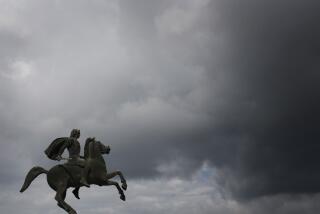BOOK REVIEW / NONFICTION : One Conquistador’s Lust for Power in the New World : HERNANDO DE SOTO: A Savage Quest in the Americas by David Ewing Duncan; Crown $35, 640 pages
- Share via
The city of Berkeley, as I recently discovered, allows its municipal employees to observe “Indigenous Cultures Appreciation Day” on what most of us regard as Columbus Day, a fact that struck me as faintly comical until I happened to read David Ewing Duncan’s biography of the Spanish conquistador Hernando de Soto.
“A man of thunder and passion, of towering ambition and brutal resolve, he epitomized everything epic, petty, grand and horrific about the conquista,” Duncan writes. “To the Indians he conquered, he must have seemed an apocalyptic figure, a terrifying and utterly alien being who appeared from beyond the edge of the world to offer impossible ultimatums, backed up by an infernal killing machine.”
Duncan regards Soto as an underappreciated figure, and his ambitious biography is intended to call our attention to Soto’s grand but bloody exploits. He was twice a conqueror, first in Central and South America and then in North America, where he lead an army of 600 Spanish soldiers on a four-year march through the interior of the unexplored continent in the early 16th century.
Soto has a following in the Old South, Duncan reports, where he is regarded in some circles as “Dixie’s first white hero.” But, as Duncan puts it, the notion of “Soto as saint is laughable.” The native-dwellers of the southeast, known generally as Mississippians, eventually drove out Soto’s army, but not before they suffered a blow that would ultimately destroy the native culture.
“The price of victory was the collapse of their civilization,” Duncan writes, “caused in part by Soto’s systematic looting of their villages, towns and cities; the kidnapping, discrediting, and murder of Mississippian leaders; and the deaths of tens of thousands killed in warfare, from being worked to death as slaves and porters, from starvation when Soto’s army plundered food supplies, and from contracting Old World diseases from which they had no immunity.”
The author draws on extensive archival research as well as his own observations; indeed, he literally retraced the likely route of Soto and his army through what is now the American South. As a result, Duncan embroiders and expands upon the biographical narrative with a vast amount of historical detail, ranging from the childhood diseases that Soto survived--”Half of all children born in Renaissance Europe died before the age of 5”--to the Quixote-esque value system of the Spanish warrior caste, known as the hidalgos, to which Soto belonged.
“The name hidalgo literally means ‘son of someone,’ ” Duncan writes, “an indicator of why Soto and his class had no greater aspiration than to be elevated to a status of high nobility, and to receive titles, land, and recognition.”
Duncan invites us to follow Soto, the knight errant, as he seeks his fortune throughout the Americas. Along the way, we encounter other--and more famous--explorers and conquerors: Balboa, Pizarro, Cortes, Ponce de Leon.
Although Duncan is describing events of immense historical scale and weight, a struggle to the death between two civilizations, he always pauses to describe what was actually happening on the ground. Thus, for example, when Duncan spends an intriguing moment describing the native weaponry that the Spaniards encountered, he notes that the conquistadors were particularly frightened by Indian snipers firing poison-tipped arrows--and he notes that the stone and hardwood clubs wielded in battle by the Indians were “beautifully carved into shapes of jaguars, boars, snakes, spheres and diamonds.”
Soto moves across the rich tableau of Duncan’s book as a complex but dynamic figure--soldier, conspirator, explorer, conqueror. Although Duncan is careful to cleave to the historical record, he is always drawn to the moments of spectacle and melodrama in Soto’s life. Sometimes, even when Duncan is reporting what he has learned through careful research, he also tells us what images are inspired in his mind’s eye.
“I imagine him strutting about the streets of Leon,” Duncan writes of young Soto at one point in the narrative, “dressed in a flashy cape and a sword glittering with inlaid swirls of gold and silver.”
“Hernando de Soto” is illuminated by a crucial insight that helps us to understand why Columbus, and not the people he misnamed the Indians, has been so celebrated in American history and culture. Soto, like Columbus and other European explorers, was impelled toward the so-called New World by the same impulse that has defined the “Manifest Destiny” of North America.
“Soto’s towering obsession was not to kill,” Duncan concludes. “It wasn’t even gold. What Soto craved, with breathlessness and insatiable ambition, was success. That was his religion, his mantra, and his fate.”
Indeed, Duncan declares Hernando de Soto to be “an American,” which he defines as “an offspring of two hemispheres conceived in violence, vitality and an insatiable lust to move forward.” It’s a provocative definition that tells us a great deal about the machinery of nation-building that Soto set into motion, an engine that is still running some 500 years later.
More to Read
Sign up for our Book Club newsletter
Get the latest news, events and more from the Los Angeles Times Book Club, and help us get L.A. reading and talking.
You may occasionally receive promotional content from the Los Angeles Times.







